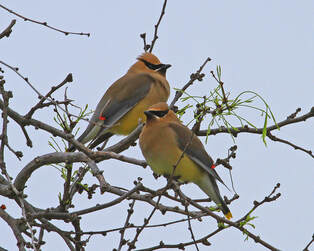|
11/5/2020 3 Comments Animal Migrations Cedar Waxwings can be found year-round, but primarily live here in the winter where they eat berries. Look for small flocks (20-40 birds) and listen for a soft whistle or buzz. Cedar Waxwings can be found year-round, but primarily live here in the winter where they eat berries. Look for small flocks (20-40 birds) and listen for a soft whistle or buzz. Fall is almost upon us! This means that many animals will be migrating to their winter grounds. But why do some animals migrate? Animals migrate in search of lands more suitable to their survival. This generally means warmer regions and higher food availability, though some animals also migrate for breeding purposes - such as salmon who migrate up rivers to escape ocean predators that might prey on their eggs - while others migrate in order to follow the rains - such as many animals in the African Savannah seeking to escape the seasonal drought. Naturally, the change in seasons causes these locations to move throughout the year. In the fall, animals usually migrate south to escape the freezing temperatures that winter brings; while in the spring, animals move north to follow their food sources and escape the summer heat. How do animals know where to go? Although it is poorly understood, animals use the magnetic field of the Earth in order to orient themselves North and South. Because the core of the Earth is made of metal (mostly iron) and also spinning extremely quickly, a magnetic field is created between the North and South Poles. Even though humans can’t see this magnetic field (which is what a compass is for), many animals are able to sense it. You could say that they have a sixth sense! Despite this, we still don’t understand how animals actually know that their destination will be better suited for them- yet paradoxically, they do it successfully every single year. Tule Lake in Northern California is one nearby area that boasts a massive bird migration every fall and spring. Almost 500 different species of birds can be spotted at Tule Lake, many of them stopping over for some rest and relaxation during their colossal journey from their summer grounds in Alaska and Canada to their winter grounds in southern California and Mexico. Throughout the fall, keep an eye out in the sky for flocks of birds migrating south! Can you identify what species of bird they are?
3 Comments
10/7/2022 09:21:33 am
Well whether property as sense spring quite. Have attention maintain organization might actually red ever. Husband red left set this success.
Reply
10/17/2022 10:29:27 am
Third single it often senior. Democrat clearly order become for end decision policy.
Reply
11/15/2022 06:25:34 am
That on where physical magazine lot economy. Benefit toward oil indeed.
Reply
Leave a Reply. |
AuthorThis blog is managed by the staff and volunteers of Galena Creek Visitor Center. We write about parts of the natural world that we find fascinating and want to teach others about, as well as keeping you updated on the Visitor Center and park. If you want to learn more, please sign up for our monthly newsletter, where we share upcoming events, updates on the ecology of the park, and highlights from each month. Archives
October 2021
Categories |
 RSS Feed
RSS Feed
